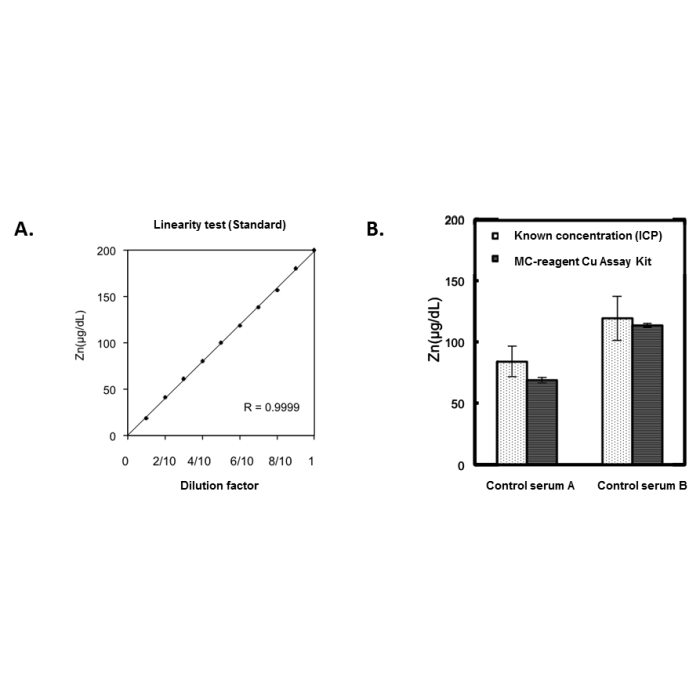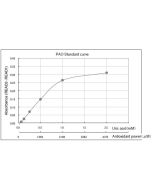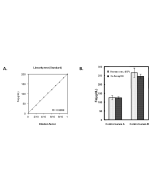Cookie Policy: This site uses cookies to improve your experience. You can find out more about our use of cookies in our Privacy Policy. By continuing to browse this site you agree to our use of cookies.
JaICA
Zinc Colorimetric Assay Kit (5-Br-PAPS Method)

| Product Details | |
|---|---|
| Product Type | Kit |
| Properties | |
| Application Set | Quantitative ELISA |
| Specificity | Specific to Zn2+. |
| Crossreactivity | All |
| Quantity | Enough reagents for 100 tests. |
| Range | 4 - 1000μg/dL |
| Sample Type |
Cell Lysate Plasma Saliva Serum Tissue Supernatant Urine |
| Detection Type | Colorimetric |
| Kit Contains |
1 x 23 ml R-1 Buffer (ready to use) 1 x 0.5 ml R-2 Chelate color (ready to use) 1 x 1.2 ml STD Zinc (Zn) standard 200 µg/dL (ready to use) |
| Other Product Data |
This MC-Reagent Zinc Assay Kit is a direct colorimetric assay based on the 5-Br-PAPS method without deproteinization of the sample. The zinc determination is based on the reaction of zinc with 5-Br-PAPS at alkaline pH in a buffered media, which forms a stable colored complex. The color intensity is proportional to the zinc concentration in the sample. Absorbance of the Zn2+-complex is measured at 560nm. Wavelength range of sensitivity: 550 ~ 580nm. Features of this Assay: Quick & Easy to use • Species independent • Highly sensitive, stable and suitable for high-throughput testing • No toxic substances • For cell lysates, serum, plasma and wide variety of biological samples |
| Declaration | Manufactured by JaICA. |
| Shipping and Handling | |
| Shipping | BLUE ICE |
| Short Term Storage | +4°C |
| Long Term Storage | +4°C |
| Handling Advice | Do not freeze. |
| Use/Stability | 12 months after the day of manufacturing. See expiry date on ELISA Kit box. |
| Documents | |
| Manual |
 Download PDF Download PDF |
| Product Specification Sheet | |
| Datasheet |
 Download PDF Download PDF |
Zinc (Zn2+) is an essential trace element, vital for the health of animals, plants, and microorganisms . Zinc is found in hundreds of enzymes, is stored and transferred in metallothioneins, and serves as structural ions in transcription factors. Zinc is often coordinated to the sides chains of amino acids, such as aspartic acid, glutamic acid, histidine and cysteine and is involved in nucleid acid and protein synthesis. It is therefore a necessary complement for cell replication. In humans, zinc interacts with a variety of organic ligands, and has roles in nucleic acid metabolism, apoptosis, neurological development, signal transduction, and gene expression. Zinc deficiency is related to skin lesions, irritability, loss of hair, growth retardation and impaired immunological functions.
- The therapeutic effect on bone mineral formation from biomimetic zinc containing tricalcium phosphate (ZnTCP) in zinc-deficient osteoporotic mice: J. Chou, et al.; PLoS One 8, e71821 (2013)
- A Primary Role for Disulfide Formation in the Productive Folding of Prokaryotic Cu,Zn-superoxide dismutase: Y. Sakurai, et al.; J. Biol. Chem. 289, 20139 (2014)









